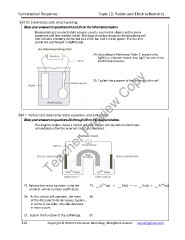Page 420 - Teacher Preview Copy
P. 420
Constructed Response . Topic 11: Redox and Electrochemistry
Set H: Electrolytic cell , electroplating.
Base your answers to questions 24 and 25 on the information below.
Electroplating is an electrolytic process used to coat metal objects with a more
expensive and less reactive metal. The diagram below shows an electroplating cell
that includes a battery connected to a silver bar and a metal spoon. The bar and
spoon are submerged in AgNO3(aq).
24. According to Reference Table F, explain why
AgNO3 is a better choice than AgCl for use in this
electrolytic process.
Teacher Preview Copy
Teacher Preview Copy
25. Explain the purpose of the battery in this cell.
Set I: Voltaic cell, balancing redox equation, and salt bridge
Base your answers to questions 26 through 28 on the diagram below.
The diagram below shows a voltaic cell with copper and aluminum electrodes
immediately after the external circuit is completed.
3+(
2+(
25. Balance the redox equation using the 25. __Cu aq) + __ Al(s) ----- > __ Cu(s) + __ Al aq)
smallest whole-number coefficients.
26. As this vol taic cell operates, the mass 26.
of the Al(s) electrode decreases. Explain,
in terms of particles, why this decrease
in mass occurs.
27. Explain the function of the salt bridge. 27.
410 Copyright © 2010 E3 Scholastic Publishing. All Rights Reserved. Survivingchem.com
Set H: Electrolytic cell , electroplating.
Base your answers to questions 24 and 25 on the information below.
Electroplating is an electrolytic process used to coat metal objects with a more
expensive and less reactive metal. The diagram below shows an electroplating cell
that includes a battery connected to a silver bar and a metal spoon. The bar and
spoon are submerged in AgNO3(aq).
24. According to Reference Table F, explain why
AgNO3 is a better choice than AgCl for use in this
electrolytic process.
Teacher Preview Copy
Teacher Preview Copy
25. Explain the purpose of the battery in this cell.
Set I: Voltaic cell, balancing redox equation, and salt bridge
Base your answers to questions 26 through 28 on the diagram below.
The diagram below shows a voltaic cell with copper and aluminum electrodes
immediately after the external circuit is completed.
3+(
2+(
25. Balance the redox equation using the 25. __Cu aq) + __ Al(s) ----- > __ Cu(s) + __ Al aq)
smallest whole-number coefficients.
26. As this vol taic cell operates, the mass 26.
of the Al(s) electrode decreases. Explain,
in terms of particles, why this decrease
in mass occurs.
27. Explain the function of the salt bridge. 27.
410 Copyright © 2010 E3 Scholastic Publishing. All Rights Reserved. Survivingchem.com


